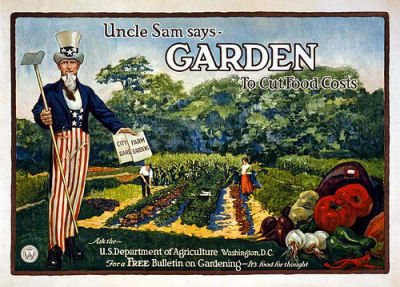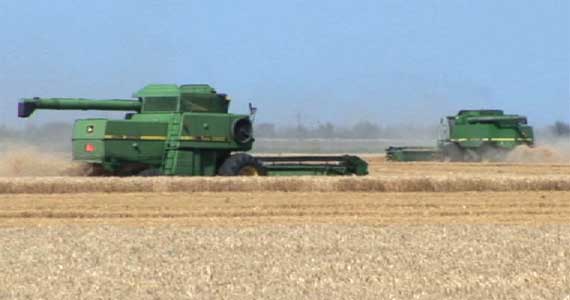Food garden in White House

In the aftermath of breaking ground on the new, 1100 square foot White House garden, Michelle Obama named chef Sam Kass to head the White House Food Initiative. And Kass isn't a fan of big agriculture and mass fertilisers.
All of this positive PR for organics feels very threatening to Big Ag. So one group, the Mid America CropLife Association, has sent an email defending chemical ag to Mrs. Obama. See the letter reprinted below.
After sending the letter, MACA forwarded it around to others, with the following message:
"Did you hear the news? The White House is planning to have an "organic" garden on the grounds to provide fresh fruits and vegetables for the Obama's and their guests. While a garden is a great idea, the thought of it being organic made Janet Braun, CropLife Ambassador Coordinator and I shudder. As a result, we sent a letter encouraging them to consider using crop protection products and to recognize the importance of agriculture to the entire U.S. economy. Read below for the entire letter.
If you want to send your own letter, it can be sent to the White House ..."
Except one person on the forward list didn't shudder at the idea of an organic garden - and that's how the letter reached the person who sent it on. Here it is:
Letter from Big Ag

"March 26, 2009
Mrs. Barack Obama
The White House
Washington, DC 20500Dear Mrs. Obama,
We are writing regarding the garden recently added to the White House grounds to ensure a fresh supply of fruits and vegetables to your family, guests and staff. Congratulations on recognizing the importance of agriculture in America! The U.S. has the safest and most abundant food supply in the world thanks to the 3 million people who farm or ranch in the United States.
The CropLife Ambassador Network, a program of the Mid America CropLife Association, consists of over 160 ambassadors who work and many of whom grew up in agriculture. Their mission is to provide scientifically based, accurate information to the public regarding the safety and value of American agricultural food production. Many people, especially children, don't realize the extent to which their daily lives depend on America's agricultural industry. For instance, children are unaware the jeans they put on in the morning, the three meals eaten daily, the baseball with which they play and even the biofuels that power the school bus are available because of America's farmers and ranchers.
Agriculture is the largest industry in America generating 20% of the U.S. Gross Domestic Product. Individuals, family partnerships or family corporations operate almost 99% of U.S. farms. Over 22 million people are employed in farm-related jobs, including production agriculture, farm inputs, processing and marketing and sales. Through research and changes in production practices, today's food producers are providing Americans with the widest variety of foods ever.
Starting in the early 1900's, technology advances have allowed farmers to continually produce more food on less land while using less human labor. Over time, Americans were able to leave the time-consuming demands of farming to pursue new interests and develop new abilities. Today, an average farmer produces enough food to feed 144 Americans who are living longer lives than many of their ancestors. Technology in agriculture has allowed for the development of much of what we know and use in our lives today. If Americans were still required to farm to support their family's basic food and fiber needs, would the U.S. have been leaders in the advancement of science, communication, education, medicine, transportation and the arts?
We live in a very different world than that of our grandparents. Americans are juggling jobs with the needs of children and aging parents. The time needed to tend a garden is not there for the majority of our citizens, certainly not a garden of sufficient productivity to supply much of a family's year-round food needs.
Much of the food considered not wholesome or tasty is the result of how it is stored or prepared rather than how it is grown. Fresh foods grown conventionally are wholesome and flavorful yet more economical. Local and conventional farming is not mutually exclusive. However, a Midwest mother whose child loves strawberries, a good source of Vitamin C, appreciates the ability to offer California strawberries in March a few months before the official Mid-west season.
Farmers and ranchers are the first environmentalists, maintaining and improving the soil and natural resources to pass onto future generations. Technology allows for farmers to meet the increasing demand for food and fiber in a sustainable manner.
Farmers use reduced tillage practices on more than 72 million acres to prevent erosion.
Farmers maintain over 1.3 million acres of grass waterways, allowing water to flow naturally from crops without eroding soil.
Contour farming keeps soil from washing away. About 26 million acres in the U.S. are managed this way.
Agricultural land provides habitat for 75% of the nation's wildlife.
Precision farming boosts crop yields and reduces waste by using satellite maps and computers to match seed, fertilizer and crop protection applications to local soil conditions.
Sophisticated Global Positioning Systems can be specifically designed for spraying pesticides. A weed detector equipped with infrared light identifies specific plants by the different rates of light they reflect and then sends a signal to a pump to spray a preset amount of herbicide onto the weed.
Biogenetics allows a particular trait to be implanted directly into the seed to protect the seed against certain pests.
Farmers are utilizing 4-wheel drive tractors with up to 300 horsepower requiring fewer passes across fields-saving energy and time.
Huge combines are speeding the time it takes to harvest crops.
With modern methods, 1 acre of land in the U.S. can produce 42,000 lbs. of strawberries, 110,000 heads of lettuce, 25,400 lbs. of potatoes, 8,900 lbs. of sweet corn, or 640 lbs of cotton lint.
As you go about planning and planting the White House garden, we respectfully encourage you to recognize the role conventional agriculture plays in the U.S in feeding the ever-increasing population, contributing to the U.S. economy and providing a safe and economical food supply. America's farmers understand crop protection technologies are supported by sound scientific research and innovation.The CropLife Ambassador Network offers educational programs for elementary school educators at http://ambassador.maca.org covering the science behind crop protection products and their contribution to sustainable agriculture. You may find our programs America's Abundance, Farmers Stewards of the Land and War of the Weeds of particular interest. We thank you for recognizing the importance and value of America's current agricultural technologies in feeding our country and contributing to the U.S economy.
Please feel free to contact us with any questions.
Sincerely,
Bonnie McCarvel, Executive Director
Janet Braun, Program Coordinator
Mid America CropLife Association
11327 Gravois Rd., #201
St. Louis, MO 63126"
Real proportion of farmers in the US
Note that Christopher Cook, in Diet for a dead planet gives the number of farmers in the US at around 2 million only now, and he comments that this is fewer than the number of Americans in prison.
As for big ag being environmentally caring ....!
Oh puhlease!
Listen to the interview with him about his research for many more realities of the unsustainable and depraved basis of our industrial economy - currently worst of all in the US but quickly turning Australia into something very similar.
As for the claims made by Big Ag above about the time needed to tend a garden - well, it certainly takes a lot longer to work to buy food and the car to tote it from the supermarket than it takes to produce enough for one person to eat! And it's a lot more enjoyable. What is hard is making a big profit out of agriculture, but that's not what you and I are necessarily seeking when we plant an easy to maintain orchard and a few vegetables. I am so over hearing how hard gardening is. Once everyone did it and had plenty of time to spare.
See also: discussion on the Life After the Oil Crash Forum

Comments
Anonymous (not verified)
Sat, 2009-04-04 19:41
Permalink
you can vote who can do
karlson (not verified)
Wed, 2010-09-29 02:54
Permalink
Vast farming land
Add comment